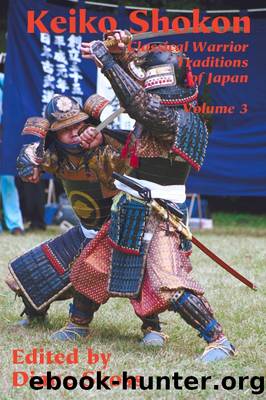Keiko Shokon by Diane Skoss

Author:Diane Skoss [Diane Skoss]
Language: eng
Format: epub
Tags: -
Publisher: BookBaby
Published: 2016-04-08T04:00:00+00:00
ITTO-RYU KENJUTSU
AN OVERVIEW
Meik Skoss
INTRODUCTION
Itto-ryu kenjutsu is one of the most significant schools of Japanese swordsmanship ever developed. It was chosen as one of the official kenjutsu ryu of the Tokugawa shogunate (Shinkage-ryu being the other). Many of the daimyo (lords of major feudal domains) throughout Japan also adopted it as an otome ryu (official system) for their own retainers.
In more recent times, the men instrumental in creating the technical curriculum of kendo (modern Japanese fencing, or swordsmanship with mock weapons made of bamboo) were greatly influenced by Itto-ryu theory and technique. Several of the men charged with creating the Dai Nippon Teikoku Kendo Kata, forerunner of todayâs Nihon Kendo Kata, were exponents of Hokushin Itto-ryu and they conferred with exponents of other branches of the Itto-ryu in order to create the forms that became the technical standard for modern kendo.
Itto-ryu has preserved a greater number of its derivative styles than any other school of kenjutsu and is today one of the most viable âfamiliesâ of classical Japanese swordsmanship. There are six lines of Itto-ryu still being practiced today, with a sufficient number of exponents and level of skill to ensure that their art will be passed on intact to future generations: Ono-ha Itto-ryu, Mizoguchi-ha Itto-ryu, Nakanishi-ha Itto-ryu, Kogen Itto-ryu, Hokushin Itto-ryu, and Itto Shoden Muto-ryu.
THE DEVELOPMENT OF ITTO-RYU KENJUTSU
Itto-ryu kenjutsu was created during the late Sengoku jidai (Warring States period, 1467â1568) by a man named Ito Ittosai Kagehisa. At the age of thirteen, Ittosai is said to have floated on a piece of timber across the Bay of Sagami to the village of Ito, on the Izu Peninsula. He supposedly lived under the floor of a local shrine and practiced swordsmanship on his own. After repelling some bandits who had threatened the village, grateful residents gave him some money and one of the swords that had been dedicated to the shrine, enabling him to begin his search for proper instruction. He studied Chujo-ryu tojutsu (swordsmanship) with Kanemaki Jissai, a student of Toda Seigen, who was famous for his superlative short sword technique, and then embarked on musha shugyo (an itinerant warriorâs journey, made for the purpose of testing or improving oneâs martial skills), traveling in the Kansai and Kanto regions.
During this âwarrior journey,â Ito had several experiences, when he spontaneously performed a movement under the stress of combat, that influenced his thinking about swordsmanship, and he later incorporated these insights into his system. The techniques he created, zetsumyo ken and muso ken, refer to the mystic, âineffable,â and âmiraculousâ nature of highly skilled swordsmanship, where trained actions take place without conscious thought. After further training and study, Ito combined the Chujo-ryu teachings with his own personal discoveries to create his own system of kenjutsu. He named it the Itto-ryu (One Sword Style), a reflection of his belief that the essence of swordsmanship could be stated in a simple phrase, itto sunawachi banto, âone sword [technique] gives rise to ten thousand sword [technique]sâ which was in turn derived from an understanding
Download
This site does not store any files on its server. We only index and link to content provided by other sites. Please contact the content providers to delete copyright contents if any and email us, we'll remove relevant links or contents immediately.
Shoe Dog by Phil Knight(4893)
The Rules Do Not Apply by Ariel Levy(4525)
Walking by Henry David Thoreau(3685)
Running Barefoot by Amy Harmon(3338)
I'll Give You the Sun by Jandy Nelson(3274)
How to Read Water: Clues and Patterns from Puddles to the Sea (Natural Navigation) by Tristan Gooley(3241)
Crazy Is My Superpower by A.J. Mendez Brooks(3205)
How to Read Nature by Tristan Gooley(3080)
How Music Works by David Byrne(2965)
The Boy, the Mole, the Fox and the Horse by Charlie Mackesy(2821)
The Fight by Norman Mailer(2706)
Seducing Cinderella by Gina L. Maxwell(2544)
Cuba by Lonely Planet(2488)
Accepted by Pat Patterson(2219)
Going Long by Editors of Runner's World(2213)
The Unfettered Mind: Writings from a Zen Master to a Master Swordsman by Takuan Soho(2159)
The Happy Runner by David Roche(2122)
Backpacker the Complete Guide to Backpacking by Backpacker Magazine(2111)
Trail Magic by Trevelyan Quest Edwards & Hazel Edwards(2058)
